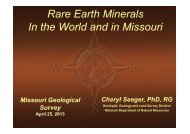You also want an ePaper? Increase the reach of your titles
YUMPU automatically turns print PDFs into web optimized ePapers that Google loves.
neodymium-145 through electron capture, a type<br />
of radioactive decay.<br />
Two other <strong>elements</strong> not with<strong>in</strong> this series, scandium<br />
(atomic number 21) and yttrium (atomic<br />
number 39) are generally <strong>in</strong>cluded with<strong>in</strong> the<br />
group of REE because of their shared occurrence <strong>in</strong><br />
nature with the lanthanides. Includ<strong>in</strong>g scandium<br />
and yttrium, there are a total of 16 naturally occurr<strong>in</strong>g<br />
REE.<br />
Rare <strong>earth</strong> <strong>elements</strong> received their name from<br />
perceived scarcity dur<strong>in</strong>g the 18 th and 19 th centuries<br />
and from ‘<strong>earth</strong>’ as an obsolete term for<br />
oxide (Hedrick, 2004; Long, Van Gosen, Foley,<br />
and Cordier, 2010). REE are now known to be<br />
relatively common with<strong>in</strong> the <strong>earth</strong>’s crust. Even<br />
the two least abundant REE, thulium (Tm) and<br />
lutetium (Lu) are <strong>in</strong> the range of 140 to 180 times<br />
more common than gold. However, economically<br />
m<strong>in</strong>eable concentrations of REE are not common.<br />
REE range <strong>in</strong> crustal abundances from cerium<br />
(25th most abundant of the 78 common <strong>elements</strong><br />
<strong>in</strong> the <strong>earth</strong>’s crust at 60 parts per million, or ppm,<br />
to thulium and lutetium (least abundant REE at<br />
about 0.5 ppm). Estimates of crustal abundances<br />
vary depend<strong>in</strong>g on the reference source.<br />
REE are subdivided <strong>in</strong>to Light <strong>rare</strong> Earth Elements<br />
(LREE) and Heavy <strong>rare</strong> Earth Elements<br />
(HREE) based on their atomic weight (table 2)<br />
(Hedrick, 2004). LREE <strong>in</strong>clude the <strong>elements</strong><br />
lanthanum (atomic number 57, atomic weight<br />
138.91) through europium (atomic number 63,<br />
atomic weight 151.96) while HREE are gadol<strong>in</strong>ium<br />
(atomic number 64, atomic weight 157.25)<br />
through lutetium (atomic number 71, atomic<br />
weight 174.97).<br />
REE <strong>in</strong> their elemental form are iron-gray to silver,<br />
malleable and ductile, soft metals that are unstable<br />
<strong>in</strong> the presence of oxygen, and readily react to form<br />
metal oxides. Chemically, REE are generally trivalent,<br />
but exceptions occur with cerium, europium,<br />
and ytterbium. Cerium forms compounds with<br />
a valence of +4. Europium can be divalent and<br />
oxidizes much more readily than the trivalent REE,<br />
form<strong>in</strong>g a yellow surface coat<strong>in</strong>g of Eu (OH) with<strong>in</strong><br />
m<strong>in</strong>utes after exposure to moist air. Ytterbium<br />
5<br />
has a closed-shell electron configuration (reluctant<br />
to share electrons with oxygen or other <strong>elements</strong>)<br />
and is thus relatively <strong>in</strong>ert; it can be handled <strong>in</strong> air<br />
and rema<strong>in</strong>s stable (Borzone and others, 1999).<br />
The reactivity of most REE is problematic for<br />
shipp<strong>in</strong>g and long-term storage <strong>in</strong> elemental form.<br />
Because of this, REE are often reported <strong>in</strong> metric<br />
tons (1 tonne = 1000 kilograms [kg]) of <strong>rare</strong> Earth<br />
oxide (rEo) with all REE lumped together. The<br />
designation total <strong>rare</strong> Earth oxides (trEo) is<br />
used <strong>in</strong> m<strong>in</strong><strong>in</strong>g and exploration to describe the<br />
total REE content <strong>in</strong> a deposit or samples <strong>in</strong> an<br />
equivalent oxide form even though their m<strong>in</strong>eral<br />
occurrence may not be <strong>in</strong> the form of an oxide.<br />
By convention, TREO addresses only 14 lanthanide<br />
series <strong>elements</strong> plus yttrium; scandium is<br />
not <strong>in</strong>cluded <strong>in</strong> TREO (Rare Element Resources,<br />
2011). A mixture of REE <strong>in</strong> metallic form (usually<br />
admixed with iron) is called misch metal, or<br />
mischmetal (Hedrick, 1985).<br />
REE with even atomic numbers, such as Ce and<br />
Nd, have greater cosmic and terrestrial abundances<br />
than adjacent REE with odd atomic numbers (La<br />
and Pr; table 1). Cerium is the most abundant with<br />
a cont<strong>in</strong>ental crustal abundance of about 60 ppm,<br />
followed by lanthanum at 34 ppm and neodymium<br />
at 33 ppm. The cumulative total abundance of<br />
REE <strong>in</strong> the <strong>earth</strong>’s crust, <strong>in</strong>clud<strong>in</strong>g scandium and<br />
yttrium, ranges from about 20 ppm to 219 ppm,<br />
depend<strong>in</strong>g on the reference cited (Long, Van<br />
Gosen, Foley, and Cordier, 2010; WebElements.<br />
com, 2012).<br />
To depict low REE concentrations and compare<br />
slight deviations between samples, this report addresses<br />
elemental concentrations <strong>in</strong> ppm. However,<br />
commercial REE assay values are, by convention,<br />
reported <strong>in</strong> terms of TREO. The difference between<br />
reported ppm <strong>in</strong> assay values and reported<br />
TREO will vary with the specific geochemistry<br />
of <strong>in</strong>dividual deposits. TREO equivalents found<br />
<strong>in</strong> Rare Element Resources’ Bear Lodge project<br />
are approximately 15.6 percent higher than the<br />
comb<strong>in</strong>ed raw metal assay values (Rare Element<br />
Resources, 2011). However, us<strong>in</strong>g the Bear Lodge<br />
deposit as a general <strong>in</strong>dication, 3,000 ppm <strong>in</strong> raw<br />
metal assay would give an estimated TREO of



